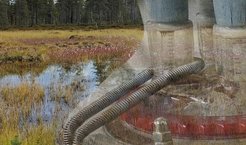Microbes Can Reduce Their Need for Nickel
Methane-producing archaea are more adaptable to nutrient-poor habitats than previously thought.
Methanogenic archaea have a significant impact on the global climate due to their role in producing almost all methane from natural sources. This well-known process relies on enzymes containing metals such as iron (Fe) and nickel (Ni). However, a team of scientists from the Max Planck Institutes for Biophysics in Frankfurt am Main and Terrestrial Microbiology in Marburg discovered that these microbes can alter the pathway they use in conditions of low nickel bioavailability (as found in many natural habitats). Their study, published in Nature, significantly advances our understanding of microbial ecology and its potential impact on climate change.
Text: Virginia Geisel
Metals play a crucial role in microbial biocatalysis by serving as cofactors for enzymes that facilitate essential biochemical reactions. Metal ions, such as nickel and iron, are often found at the active site of enzymes, where they enable electron transfer and thus the conversion of substrates. Previous studies have shown that methanogenic archaea that live on hydrogen (H₂) rely on [NiFe]-hydrogenases. In the context of methanogenesis, these enzymes convert hydrogen gas into methane and are involved in the energy-coupling mechanism of the flavin-based electron bifurcation (FBEB) reaction. The Marburg researchers Prof. Dr. Rolf Thauer and Prof. Dr. Wolfgang Buckel had discovered this key reaction that enables microbes to efficiently utilise energy.
However, this pathway was identified by culturing methanogenic microorganisms isolated from natural environments using laboratory media with nickel ion concentrations more than 100 times higher than in nature, where habitats are usually strictly nutrient-limited. Indeed, very low concentrations of bioavailable metal ions have been reported in seawater and freshwater environments. Can methane also be produced under these conditions, and if so, how? To address this question, Dr Seigo Shima led a research team at the Max Planck Institute for Terrestrial Microbiology to study methanogenesis under nutrient-limited conditions.
'We were surprised to find that the levels of [NiFe]-hydrogenases in these methanogenic archaea had decreased to almost zero,' says Dr Shunsuke Nomura, the study's lead author. Instead, the catabolic hydrogen pathway appeared to be entirely replaced by a non-nickel enzyme system.

Dr. Bonnie Murphy, from the Max Planck Institute for Biophysics in Frankfurt, explains: 'Our cryogenic electron microscopic analysis revealed a complex enzyme structure without nickel that can function as the electron-donating system for the FBEB reaction in the methanogenic pathway, thereby replacing [NiFe] hydrogenases.' A comparative genomic analysis suggests that this novel methane metabolism is widespread in nature and may help organisms to adapt to their environment and survive in the absence of nickel.
According to traditional textbooks, nickel-containing hydrogenases are the only functioning hydrogenases in methanogenic microbes. However, our findings reveal that this is no longer the case. The complete disappearance and replacement of the nickel-containing hydrogenase enzyme represents a significant paradigm shift in methanogen research and challenges our understanding of methanogenic metabolism in nature”, says Seigo Shima.
This is particularly intriguing because nickel-containing and non-nickel hydrogenases are completely unrelated. They have different protein structures, active site characteristics, reaction mechanisms, and inhibitor sensitivities. This discovery highlights the importance of understanding the physiological responses of microorganisms in different environments, given that methanogenic activity contributes significantly to greenhouse gas emissions. By further investigating the alternative pathway, the researchers hope to develop more effective strategies for reducing methane's impact on the global climate.












